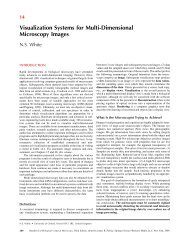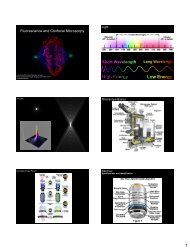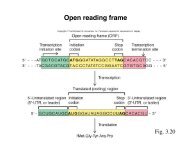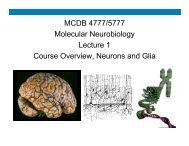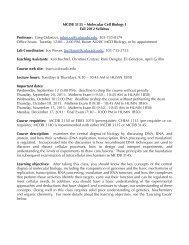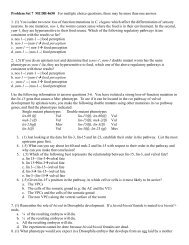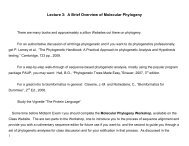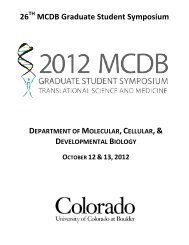Wnt Signaling Polarizes an Early C. elegans ... - MCD Biology
Wnt Signaling Polarizes an Early C. elegans ... - MCD Biology
Wnt Signaling Polarizes an Early C. elegans ... - MCD Biology
You also want an ePaper? Increase the reach of your titles
YUMPU automatically turns print PDFs into web optimized ePapers that Google loves.
Cell<br />
702<br />
Discussion<br />
We isolated mutations in 5 maternally expressed genes,<br />
mom-1 through mom-5, each required for induction of<br />
endoderm during embryogenesis in C. eleg<strong>an</strong>s. One<br />
gene required for endoderm induction, mom-2, is predicted<br />
to encode a member of the widely conserved<br />
<strong>Wnt</strong> family of secreted glycoproteins. These signaling<br />
proteins polarize cell fates across tissues <strong>an</strong>d in some<br />
cases are known to polarize individual cells (Nusse <strong>an</strong>d<br />
Varmus, 1992; Parr <strong>an</strong>d McMahon, 1994; Herm<strong>an</strong> et al.,<br />
1995; Miller <strong>an</strong>d Moon, 1996). mom-2/<strong>Wnt</strong> signaling<br />
specifies endoderm by posttr<strong>an</strong>scriptionally down-regulating<br />
the HMG domain protein POP-1 in the posterior<br />
daughter of <strong>an</strong> early blastomere. Widespread defects in<br />
mitotic spindle orientation in mom-2; mom-1 double<br />
mut<strong>an</strong>t embryos suggest that <strong>Wnt</strong> signaling influences<br />
the cytoskeleton to regulate polarity in blastomeres<br />
throughout the early embryo.<br />
Figure 6. mom-2 Acts to Negatively Regulate pop-1 in E <strong>Wnt</strong> <strong>Signaling</strong> Specifies Endoderm<br />
(A) Immunofluorescence micrographs of pop-1, mom-2, <strong>an</strong>dpop-1; in C. eleg<strong>an</strong>s Embryos<br />
mom-2 embryos fixed <strong>an</strong>d stained with J126 to detect intestinal Our genetic <strong>an</strong>d molecular <strong>an</strong>alyses of mom-2 indicate<br />
cells. pop-1 embryos produce twicethe normal amount of endoderm<br />
(a), while most mom-2(or42) embryos fail to make <strong>an</strong>y (b). pop-1;<br />
mom-2 embryos make twice the normal amount (c); laser ablation<br />
experiments show that both MS <strong>an</strong>d E make gut in pop-1; mom-2<br />
double mut<strong>an</strong>t embryos, as in pop-1 alone (see text). When pop-1<br />
that <strong>Wnt</strong> signaling from P2 at the 4-cell stage polarizes<br />
the ventralmost blastomere EMS, thereby distinguishing<br />
endoderm from mesoderm. The <strong>Wnt</strong> signal tr<strong>an</strong>sduction<br />
pathway has been conserved throughout <strong>an</strong>imal evolu-<br />
function was eliminated in homozygous mom-4 mut<strong>an</strong>t mothers tion, being found in metazo<strong>an</strong> org<strong>an</strong>isms as diverse as<br />
by RNA-mediated gene silencing (see Experimental Procedures), hum<strong>an</strong>s, fish, frogs, insects, mice, <strong>an</strong>d nematodes<br />
mut<strong>an</strong>t embryos produced intestinal cells comparable in number to<br />
those made by pop-1 mut<strong>an</strong>t embryos (n 43).<br />
(B) Immunofluorescence micrographs of wild-type <strong>an</strong>d mom-2(or42)<br />
embryos, stained with POP-1 <strong>an</strong>tiserum. The embryos are oriented<br />
with the <strong>an</strong>terior end to the left, <strong>an</strong>d the ventral surface toward the<br />
(Nusse <strong>an</strong>d Varmus, 1992; Parr <strong>an</strong>d McMahon, 1994;<br />
Herm<strong>an</strong> et al., 1995). Intriguingly, we have shown that<br />
three genes, mom-1, mom-2, <strong>an</strong>d mom-3, are required<br />
in P2 for signaling; only two genes, porcupine <strong>an</strong>d wing-<br />
lower part of the photo. In the wild-type embryo, MS (indicated by less, are known to be required in signaling cells for <strong>Wnt</strong><br />
the arrow) contains higher levels of POP-1 th<strong>an</strong> does E (arrowhead). pathway function in Drosophila (Kadowaki et al., 1996).<br />
We observed this pattern in 19 of 24 wild-type embryos, similar to<br />
the frequency reported in Lin et al., 1995. In 39 of 53 mom-2(or42)<br />
embryos, <strong>an</strong> example of which is shown here, E <strong>an</strong>d MS accumulate<br />
equal levels of POP-1. In both of the 7-cell stage embryos shown<br />
here, no staining is visible in P2, which is in mitosis. Equal levels of<br />
staining are visible in the four AB descend<strong>an</strong>ts.<br />
Homozygous mom-1 <strong>an</strong>d mom-3 hermaphrodites, in ad-<br />
dition to producing mom mut<strong>an</strong>t embryos, have protrud-<br />
ing vulvae, exhibit a highly penetr<strong>an</strong>t egg-laying defect,<br />
are mildly uncoordinated <strong>an</strong>d often rupture at the vulva<br />
upon reaching adulthood (C. J. T., A. S., <strong>an</strong>d B. B.,<br />
unpublished data). As mom-2 <strong>an</strong>imals do not show these<br />
zygotic defects, mom-1 <strong>an</strong>d mom-3 may regulate the<br />
mom-1 embryos exhibited widespread abnormalities in function of other C. eleg<strong>an</strong>s <strong>Wnt</strong>(s) during larval devel-<br />
mitotic spindle orientation <strong>an</strong>d blastomere positioning.<br />
In some embryos, C, a daughter of P2, divided d/v in-<br />
opment.<br />
stead of a/p, <strong>an</strong>d 16-cell stage AB descend<strong>an</strong>ts divided mom-2/<strong>Wnt</strong> <strong>Signaling</strong> Down-Regulates<br />
with r<strong>an</strong>dom orientations (data not shown). In a few the HMG Domain Protein POP-1<br />
cases, posterior <strong>an</strong>d ventral blastomeres moved to the Our <strong>an</strong>alysis of endoderm induction demonstrates that<br />
<strong>an</strong>terior end of the embryo, displacing the cells normally <strong>Wnt</strong>-mediated signaling downregulates POP-1 in the E<br />
there (compare Figures 3D <strong>an</strong>d 3I). No defects were daughter of EMS. For example, the opposite phenotypes<br />
observed in the orientation of the mitotic spindles in the of pop-1 <strong>an</strong>d mom-2 mut<strong>an</strong>ts <strong>an</strong>d the finding that pop-1;<br />
germline precursors P0,P1,P2, <strong>an</strong>d P3 (Figure 3K, data mom-2 double mut<strong>an</strong>ts resemble pop-1 single mut<strong>an</strong>ts<br />
not shown), lending support to the notion that germline suggest that mom-2 acts upstream to regulate pop-1<br />
precursors possess <strong>an</strong> intrinsic polarity (Schierenberg, negatively. Furthermore, in wild-type embryos POP-1 is<br />
1987). Whether the abnormal positioning of blastomeres present at high levels in the nucleus of MS but not of<br />
in some mom-2; mom-1 embryos results indirectly from E, <strong>an</strong>d only E makes endoderm (Lin et al., 1995). In<br />
spindle orientation defects or is caused by ch<strong>an</strong>ges in mom-2 mut<strong>an</strong>ts, nuclear POP-1 levels are high in both<br />
cell adhesion or migration is not clear. These data indi- EMS daughters, <strong>an</strong>d both adopt MS-like fates. Thus,<br />
cate that <strong>Wnt</strong> signaling influences cell polarity in somatic <strong>Wnt</strong> signaling from P2 polarizes EMS such that nuclear<br />
blastomeres throughout the early embryo <strong>an</strong>d suggest levels of POP-1 are down-regulated in E, permitting en-<br />
that <strong>Wnt</strong> signaling regulates cytoskeletal polarity.<br />
doderm fate. As pop-1 mRNA is maternally provided,





